How to fix iPhone not showing up in Windows Explorer?
Apr 26, 2023 pm 05:34 PMiPhone users always have to use Windows/Mac system to backup data by transferring files because iPhone storage is not consumable. While performing this task, the issue of iPhone not showing up on Windows Explorer on the system arises.
This issue prevents users from accessing files or any content on iPhone on their Windows system. The potential cause of this issue could be one of the following reasons.
- Faulty computer USB cable or USB port
- Outdated Apple mobile software
- Unable to control the iTunes folder on the system
- On iPhone Internal Technical Problem
- No Apple Device USB Driver
After listing all the possible causes, we have researched them in depth and compiled them in the article below a set of solutions.
Initial Fix
- Check USB Cable - This can be mostly due to a damaged USB cable or sometimes due to the use of an unauthorized USB from a third party seller cable. So, check if the USB cable is damaged or broken and then try to replace it with the original USB cable.
- Try using a different USB port – Many users find that the USB port does not work properly, which causes problems. So, try connecting your iPhone to another USB port on your Windows system via USB cable and see if this works. Also, try to repair the faulty USB port.
- Update iPhone Software - This may be a common cause, but checking if your iPhone's software is up to date can resolve this issue. So, try updating iOS on your iPhone.
- Make sure your Windows system is updated – Sometimes, we tend to ignore Windows update notifications, which can lead to such issues. So, go to the Windows Update page and if there are any updates available, download and install them.
- RestartiPhone - Most iPhone users resolve this issue simply by restarting their iPhone to remove any minor software errors. Therefore, we recommend our users to try restarting their iPhone once and check if this helps them.
Solution 1 – Try switching to the MTP driver for Apple USB devices
If the current Apple USB device driver is causing this issue, you can always use the one mentioned below Steps Install Default Driver to try the default driver.
Step 1: Press the Windows key and type Device Manager.
Step 2: Now, select the "Device Manager" option from the search results under "Best Matches" as shown below.

Step 3: Once the Device Manager opens, double-click the Universal Serial Bus Devices option to expand it.
Step 4: Then right-click the Apple Mobile Device USB Composite Device and select the Update Driver option from the context menu.

Step 5: Click BrowseMy Computer to find the driver.

Step 6: Next, select the Let me choose from a list of drivers available on my computer Click on it option.

Step 7: Now click on MTP USB Device and then click on Next to continue as shown below.

Solution 2 – Full Control of iTunes Folder
iPhone cannot appear in Windows Explorer when you cannot access the iTunes folder on your system superior. So, try the following steps to take full control of your iTunes folder.
Note - Please make sure you have the iTunes application installed on your system. If not, install it.
Step 1: Press the Window and E keys simultaneously to open the Windows Explorer window.
Step 2: Nowdouble-click on the "Music" folder and right-click on the iTunes file in it folder.
Step 3: SelectFeatures The options in the contextual menu are as follows.

General tab and uncheck Read Only (Applies Only files in the folder)" attribute.
Step 5: Then click Apply and OK.

Step 6: Once completed, check if the issue has been resolved .
Step 7: If not, use steps 1-3 to go to the iTunes Properties window again.
Step 8: Now click on the “Security” tab and then click on the “Edit” option.

Step 9: In the "Permissions for iTunes" window, make sure you have allowed the system to have Full Control permissions on the iTunes folder.
Step 10: Finally, click "Apply" and "OK".

Solution 3 – Unplug the USB cable and restart the system
Step 1: First, you need to remove the USB cable by unplugging it Unplug from the Windows system.
Step 2: After unplugging the USB cable, restart the Windows system.
Step 3: To do this, right-click the Start Menu button (blue square) and hover over # in the context menu ##"Close or logout" option as shown below.
Step 4: Then click theRestart option in the side drop-down menu list.

right-clicking"Start" in the taskbar #" menu button and click "Device Manager" in the context menu list to launch Device Manager.
Note- You need to connect your iPhone to your Windows system via Apple's Lightning USB cable.
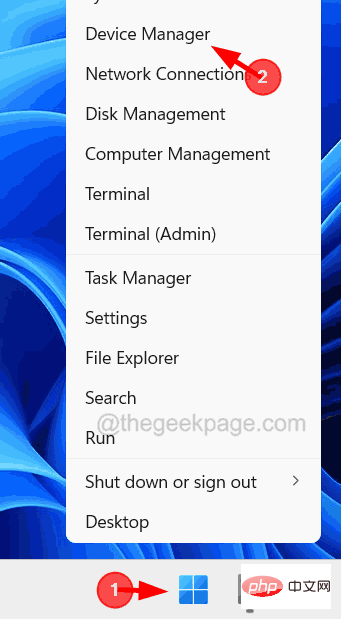 Step 2: When the Device Manager window appears, search for the "Portable
Step 2: When the Device Manager window appears, search for the "Portable
" option from the "Devices" list and double-click Expand it. Step 3: Now
right click on theApple iPhone and select the Update Driver option from the context menu.
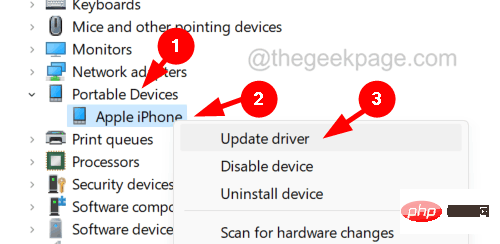 Step 4: Select the
Step 4: Select the
option in the pop-up window on your screen.
 #Step 5: This will start searching online for the latest driver for your Apple iPhone device and install it.
#Step 5: This will start searching online for the latest driver for your Apple iPhone device and install it.
Step 6: Once completed, you can close Device Manager.
Step 7: Disconnect the iPhone from the Windows system and try to reconnect again.
Then check if it appears in the Windows Explorer window.
Solution 5 – Try updating the USB device driver
Step 1: Open the
Runcommand box by pressing Windows and R simultaneously key. Step 2: Next, type
devmgmt.mscin the text box of the Run Command window as shown below and then press Enter.
 Step 3: This will open the Device Manager
Step 3: This will open the Device Manager
your Windows system. Step 4: Now find the
Universal Serial Bus Deviceoption from the device list and double click on it to expand it. Step 5: After that,
Double-clickApple Mobile Device USB Composite Device The options below it are as shown in the picture.
 Step 6: This will open the
Step 6: This will open the
" window. Step 7: Now click on the "Driver" tab and then click on
"Update Driver" under this tab as shown in the image.
 Step 8: You will see an Update Driver window on your screen.
Step 8: You will see an Update Driver window on your screen.
Step 9: Select the "Automatically search for drivers " option, which will start updating it by searching online.

Step 10: Once completed, try to reconnect your iPhone to the Windows system by unplugging and plugging it back in.
Solution 6 – Reset Location and Privacy Settings on iPhone
Step 1: Disconnect your iPhone from the system by unplugging the USB cable ## Then you have to open the "Settings" app on your iPhone. Step 2: Go to the
Company Information option.
 Step 3: Click
Step 3: Click
by scrolling at the end of the "General" page.
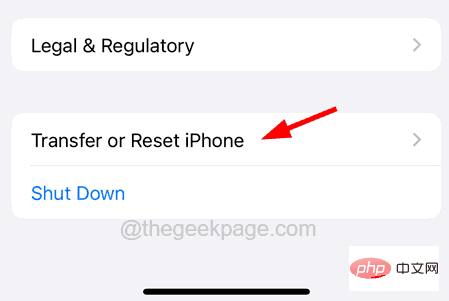 Step 4: After that, select the
Step 4: After that, select the
option at the bottom.
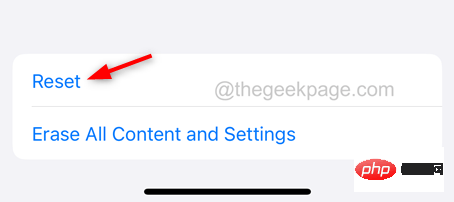 Step 5: Select the Reset
Step 5: Select the Reset
and Privacy option from the context menu that pops up on your iPhone screen.
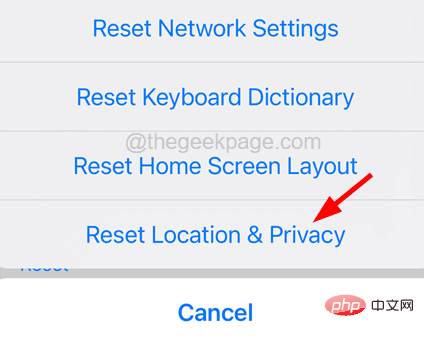
continue. Step 7: Then you have to click
Reset Settingson the popup menu again.
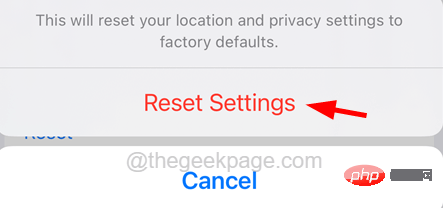 Step 8: This will reset the location and privacy settings on your iPhone.
Step 8: This will reset the location and privacy settings on your iPhone.
Step 9: Once completed, try to connect your iPhone to the system via USB cable.
Step 10: This time, it will ask you to accept the pop-up on your iPhone screen by clicking
Trust.The above is the detailed content of How to fix iPhone not showing up in Windows Explorer?. For more information, please follow other related articles on the PHP Chinese website!

Hot AI Tools

Undress AI Tool
Undress images for free

Undresser.AI Undress
AI-powered app for creating realistic nude photos

AI Clothes Remover
Online AI tool for removing clothes from photos.

Clothoff.io
AI clothes remover

Video Face Swap
Swap faces in any video effortlessly with our completely free AI face swap tool!

Hot Article

Hot Tools

Notepad++7.3.1
Easy-to-use and free code editor

SublimeText3 Chinese version
Chinese version, very easy to use

Zend Studio 13.0.1
Powerful PHP integrated development environment

Dreamweaver CS6
Visual web development tools

SublimeText3 Mac version
God-level code editing software (SublimeText3)
 How to create a contact group on iPhone
Jul 13, 2025 am 01:17 AM
How to create a contact group on iPhone
Jul 13, 2025 am 01:17 AM
iPhone does not support creating contact groups directly in the address book application, but similar functions can be achieved through the following methods: 1. Use the "Group" function in the address book application, click "Edit" > "Add Group" to create a custom group; 2. Add each contact to the corresponding group by editing it; 3. If you need to send a group message, you can create a new multi-person conversation in the information application; 4. Use iCloud or Gmail to synchronize tagged groups to facilitate the management of a large number of contacts on the computer. These methods are used in conjunction with efficient management of contact groups.
 How to check if an iPhone is unlocked
Jul 15, 2025 am 01:17 AM
How to check if an iPhone is unlocked
Jul 15, 2025 am 01:17 AM
TocheckifaniPhoneisunlocked,1)gotoSettings>Cellular>CellularDataOptionsandlookforlabelslike“Unlocked”or“NoSIMrestrictions,”2)insertadifferentcarrier’sactiveSIMcardandseeifthephoneacceptsit,3)usetheIMEInumberononlinetoolslikeIMEI.infotocheckunlo
 How to check iPhone trade-in value
Jul 13, 2025 am 01:13 AM
How to check iPhone trade-in value
Jul 13, 2025 am 01:13 AM
Determining the depreciation value of iPhone requires multiple factors and comparing different platforms. 2. The first choice is Apple's official replacement plan, which has a simple and transparent process, but the final valuation must be based on the actual condition of the equipment. 3. Third-party websites such as Gazelle, Swappa, etc. may provide higher quotations, but you need to pay attention to describing the real situation and avoiding the charging trap. 4. The core factors affecting value include model and storage capacity, equipment status, operator lock status, etc. Small problems may also affect the quotation. 5. If you pursue higher returns, you can choose to sell privately, but you need to weigh the time cost and transaction risks.
 How to transfer contacts from one iPhone to another
Jul 12, 2025 am 02:36 AM
How to transfer contacts from one iPhone to another
Jul 12, 2025 am 02:36 AM
Migrating contacts can be accomplished in three ways when replacing a new iPhone: First, using iCloud synchronization is the most worry-free, ensuring that the old phone has turned on the iCloud address book backup, and the new phone logs into the same account and enables synchronization; Second, using AirDrop is suitable for a small number of contacts to transmit. After setting up AirDrop visibility on both phones, sending and receiving them through the share button; Third, with the help of computer relay, both Mac or Windows, synchronizing contacts through Finder or iTunes and replacing or merging data. Select the method that suits you and pay attention to your account and permission settings to easily complete the migration.
 How to buy stablecoins for Apple phones? Where to buy stablecoins for Apple phones?
Jul 24, 2025 pm 09:18 PM
How to buy stablecoins for Apple phones? Where to buy stablecoins for Apple phones?
Jul 24, 2025 pm 09:18 PM
Purchase USDT and other stablecoins on Apple phones, you must download the compliant exchange app through the overseas Apple ID and complete the authentication and conduct transactions. The specific steps are as follows: 1. Use Apple ID in the non-mainland region to log in to the App Store; 2. Download recommended platforms such as OKX, Binance, Huobi (HTX), Gate.io or KuCoin; 3. Complete registration and identity authentication (KYC); 4. Enter the "Buy Coin" or "C2C/P2P Transaction" page to select USDT; 5. Filter merchants according to the payment method and place orders; 6. Pay through Alipay, WeChat or bank card and confirm transactions; 7. Wait for the merchant to put the coins into the account, and the entire process is completed.
 How to clear RAM on iPhone
Jul 12, 2025 am 02:30 AM
How to clear RAM on iPhone
Jul 12, 2025 am 02:30 AM
The RAM of iPhone cannot be cleaned manually, but the following methods can be used to free memory to improve smoothness: 1. Close the background application: Double-click the Home button or slide from the bottom to pause and close the card; 2. Restart the phone regularly: Refresh the system status once a week; 3. Reduce background refresh: Enter Settings → General → Backend App Refresh to limit the number of applications; 4. Avoid running multiple high-resource applications at the same time, and use them in stages to reduce memory pressure. These operations can effectively alleviate the lag caused by the tight memory of iPhone.
 Forgot iPhone passcode
Jul 26, 2025 am 09:53 AM
Forgot iPhone passcode
Jul 26, 2025 am 09:53 AM
If you forget your iPhone password, you can try the following methods: 1. Use iTunes/Finder to enter recovery mode to restore the device (must be connected to the computer); 2. If you enable "Find My iPhone", you can erase the device through iCloud; 3. Contact Apple customer service for assistance (need to provide a purchase certificate). The first two of the above methods will clear the data. It is recommended to backup regularly in the future and enable the search function.
 How to use the Files app on iPhone
Jul 19, 2025 am 01:48 AM
How to use the Files app on iPhone
Jul 19, 2025 am 01:48 AM
Using the iPhone's file app for file management is very simple and suitable for daily tasks. 1. Organize files and folders: Folders can be created through the "New Folder" function, and supports renaming, moving or copying files. They can also be sorted by name, date, etc. 2. Access iCloud and other cloud services: You can connect to iCloudDrive, GoogleDrive, Dropbox, etc., manage the displayed services through "Browse>Location>Edit", and directly save files to cloud storage. 3. Open and share files from other applications: Select the application to open the file through the share icon at the bottom, or share files through email, message or AirDrop. In short, although its functions are limited, its basic





